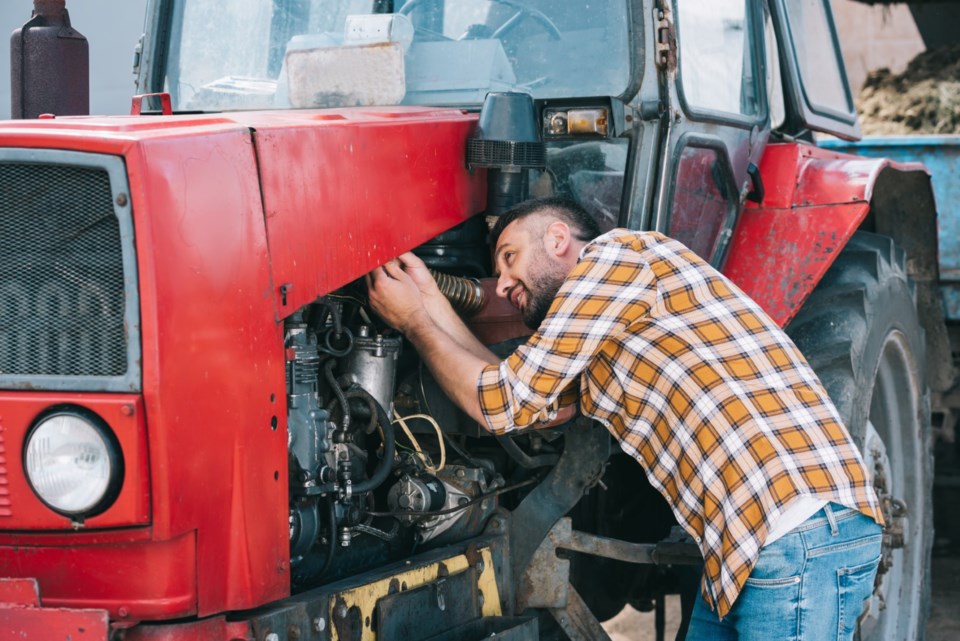WESTERN PRODUCER — Like many other producers, Jake Ayre spends a fair amount of time on the following question: fix it or trade it in?
“Every farmer probably has this case: do I pay that $50,000 repair bill on this combine or tractor? Or do I look at taking that $50,000 and putting it on a down payment on something a little newer,” said Ayre, who farms near Minto, Man., and operates 小蓝视频ern Seed with his dad, Andrew.
Producers commonly dedicate more time to the “fix or replace” problem because the cost of combines, tractors, sprayers, balers and other machinery has skyrocketed in North America.
Every two years, farm management experts with Manitoba Agriculture publish a report on the cost of farm equipment.
Their most recent report, , says prices for some equipment have climbed 25 to 62 percent in the last two years.
“I’ve been doing this for quite a few years now (the machinery cost report),” said Darren Bond, a farm management specialist with Manitoba Agriculture.
He said normally, prices increase by two to five percent per year.
“That would be a four to 10 percent increase over the two-year span.
“Obviously, we’ve really eclipsed this (rate of increase).”
Increases over the last two years include:
- medium, front-wheel assist tractors (160-224 horsepower), $350,000, up 35 percent
- four-wheel drive tractors (550 hp or more), $725,000, up 28 percent
- Class 9 combines, $850,000, a jump of 27 percent
- large air drill/seeders with independent openers, $950,000, up 62 percent
The rapid rise in air drill prices isn’t just about inflation.
The latest models are larger and more elaborate than the previous generation.
“I would point to the air tanks and how big they’ve (become). Now we’re seeing air tanks (that are) well over 1,000 bushels,” Bond said. “Those size of carts… you need flotation options, you need two fans, dual shoot… separate fertilizer placement… all the electronics that go with it. It just adds, adds and adds (to the cost).”
Bond also discussed the price of combines.
A Class 8 combine can cost $750,000, without a header.
The header will add $70,000 to $140,000 to the price.
Then there are the options.
“Take a combine, a track option is $100,000,” Bond said.
“These options on these pieces of equipment can just go through the roof.”
Bob Cochran, chair of the Agricultural Manufacturers of Canada, said some price increases are connected to the pandemic.
In the post-pandemic period, 2021-23, the cost of materials and products needed to make farm equipment increased 20-30 percent, he said in an email.
“This includes materials such as steel, rubber, hydraulic components and electrical components to name a few. In many cases, supply was very limited and manufacturers were challenged to even secure that supply in order to keep producing equipment,” said Cochran, general manager of Highline Manufacturing, which makes bale processors, feed mixers and other equipment in Vonda, Sask.
The cost of materials and components has moderated, but prices haven’t returned to pre-pandemic levels, he explained.
Operating a manufacturing plant has also become more expensive because of costs like fuel, labour and natural gas.
Cochran added that farm machinery has become more complex, including the technology to precisely apply fertilizer, seed and pesticides.
“There are costs associated with this technology but there are also cost savings (for producers) as compared to past practices.”
With higher prices for new and used machinery, farmers are seeking ways to control those costs.
On Ayre’s grain farm, he always compares leasing and financing the purchase of machinery.
He also thinks about the risk of a $75,000 repair and how to manage that risk.
“What kind of hours are you going to put on the machine? For us, the piece of equipment we put the most hours on is the sprayer,” he said.
“As soon as you start getting up in hours in a machine, no matter what colour it is, you’re going to see more repairs…. The farmer that’s running the (leased) equipment, you’re responsible for the repairs…. When you’re in the lease cycle, you don’t typically run that machine for the lifetime of the lease. It (might) be half way through the lease.”
So, Ayre might swap a 2014 sprayer for a 2019 model at the dealership, to reduce the possibility of a breakdown.
Regardless of the on-farm strategy, the Manitoba Agriculture report indicates that equipment has become expensive.
Cochran acknowledged prices can only go so high.
If the price point for a particular machine doesn’t make sense, farmers will make other choices.
“While manufacturers can only remain in business if a profit is generated, they are cognizant of the need to price their product at an affordable level,” he said.
“I expect Canadian farm equipment manufacturers will continue to keep the value proposition for the farmer in mind when setting the pricing of the machines they produce. If they don’t… the products won’t sell.”
Bookmark SASKTODAY.ca, Saskatchewan's home page, at this link.




